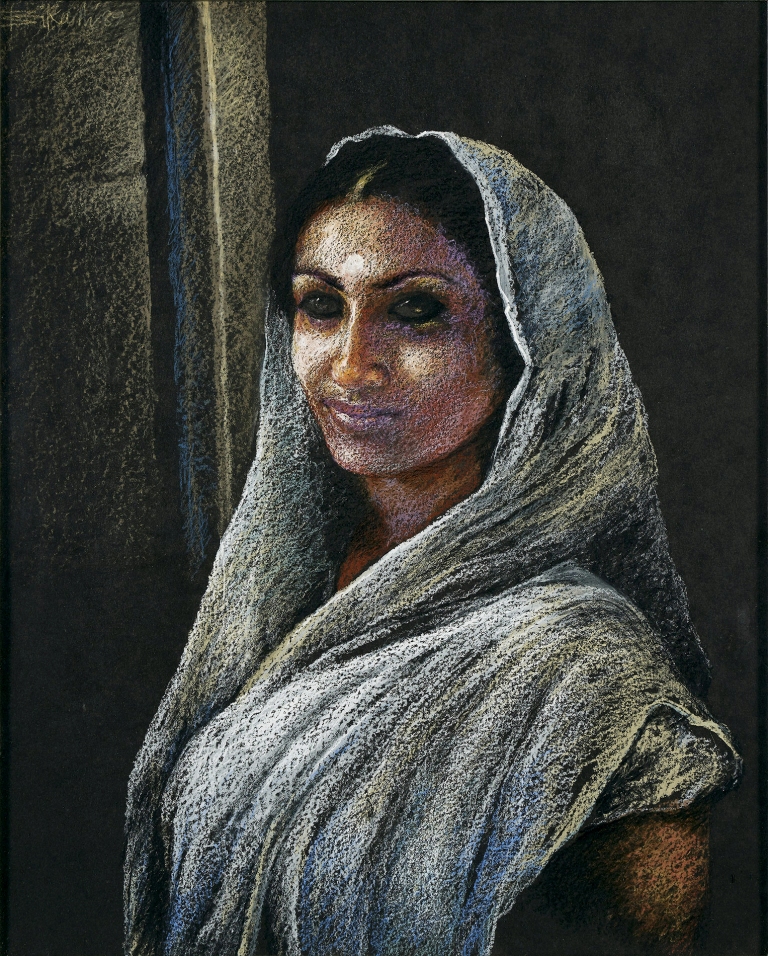OF THE HOUR GLASS AND THE MOVIN G IMAGES OF
ETERNITY IN THE WORKS OF SANGEETA GUPTA
Dr. Aparna Roy Baliga
Shiva, the ultimate creator, does his Tandava to destroy all that has become irrelevant and unnecessary, and in the process creates a new world order. The time and space zones only exist in our mind and they are only relative in its quantification. For the spirit time and space do not matter.
My concern is to connect, with myself and for that one needs to do one’s Tandava, one’s own dance and then liberate oneself of the mundane to reach one’s core. Ujjain, Mahakaal and Mahakumbh all inspire one to do one’s dance and connect to one’s inner self “The Spirit.”
I have painted the dance playing with yellow, red and orange which are meditative pure and intense as the Prana itself.
Sangeeta Gupta
The work of Sangeeta Gupta goes beyond the temporal physical space; it’s the retinal sensation of surfaces which comes after intellectual sieving. She doesn’t directly paint what she sees around herself, the forms are not describable. While one tries to trace the sources of the images one reaches the actual painting activity or the non-objective arrival of the patterns, textures and splashes. Paul Klee in his Thinking Eye speaks about the artist’s mission to penetrate as far as may be towards that secret ground where the primal law feeds growth. If one extends the word primal one is also reminded about the word essential/elemental. She mentions about the Panchata ttva:Kshiti,tej,ap,marut,vyom, the five constituents of nature which is being represented by her rather than the entire objective presence of the world. She moves away from her early figurative works and looks away from the particular body to the idea of its presence. Borders are fluid between sensation, imagination and memory. She does not perceive the objects as they are but how they act upon her, her responses to them. Memories of Gaitonde, Nasreen, Raza and Swaminathan often pass in a fleeting moment. Their attempts of gleaning from the philosophical traditions of Zen, Sufism and other philosophical thoughts find a resonance in the works of Sangeeta Gupta. She engages with diverse creative forms like painting, photography and film. She learnt painting from Sanat Roy while she was posted in Kolkata and also had her first solo there in 1995. She is also an avid reader of poetry and philosophy and has quite a number of publications to her credit. Her job which makes her travel from one place to the other informs her about the varied experiential realities which get registered on the surfaces of her canvas. The textures often play the dual role as the physical presence of the paint or the deliberations of a painter in formal experiments of mark making tracing the remnants of her visual journey in Benares of the rich textiles, the memories of the warp and the weft and the textured woven drapes.
She often brings the painter’s practice of translating the optical perceptions to the pigments which she rubs with her own hands, erasing any mediation of the tools like brushes or spatula. Meticulously she works with the textures derived from various forms of nature. She erases and renders, forms are done and undone on the surface, and forms are visible, floating sections of vast colour fields. They are all beyond boundary, speaking about the artist’s aspiration to reach that meditative peak. Layering of colours one above the other often shows the luminescence hidden beneath that strata.The multitude of forms swarm as textures of various shapes. It’s not only about the natural forms but the innumerable material objects with various textural and formal possibilities throng her canvases. My abstract world: a series from her digital works speak volumes about how a beehive is being analysed in metric rhythm, there takes place dematerialization, how they disperse and liquefy into diverse forms, jewelleries lose their contours, what they leave are the textures and shapes in numerous imprints. Gaitonde said, ‘the humblest of things, when meditated upon can give rise to the most astounding

